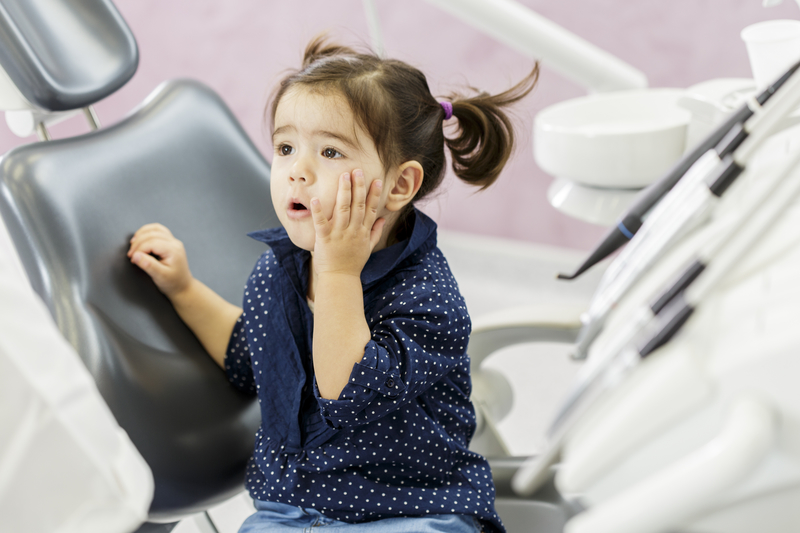Prevent Cavities with Free Infant Dental Exams
Fluoride: How Important Is It?
July 11, 2018Help Kids Like the Dentist with Laser Dentistry!
July 26, 2018
At Hardy Pediatric Dentistry & Orthodontics, we want the best for your child, just like you do. This is why we offer a free infant dental exam for families! The American Academy of Pediatric Dentistry recommends children be seen for an exam as early as 1 year of age or within 6 months of the eruption of the first baby tooth. Let us help you with the best prevention strategies, education and success tips for helping your child to have a healthy smile!
Taking Care of an Infant’s Teeth
When your tiny infant starts to get their first tooth, it can be quite an exciting time! It can also be a stressful time, as babies tend to fuss more, cry, fever, have trouble eating and more when they start to teeth. This may be a time of less sleep for a parent, but it is a normal process for an infant. Even though you can’t always control their eating or sleeping habits as they get teeth, you can control how clean those tiny teeth stay.
There is toothpaste and toothbrushes made for infants that you can get to keep their tiny teeth free of decay. Baby toothbrushes will be small or they can even be gum brushes. If you choose a gum brush, these will look like small rubbery attachments that you place over one of your fingers. You put baby toothpaste on the brush and use the finger brush to brush their tiny tooth. Sometimes, gum brushes are preferable if you infant only has one or a few teeth.
Only use a rice-sized amount of toothpaste for an infant (or less) when brushing their tooth. It will only take a few strokes depending on how they cooperate, but anything is better than nothing. Try to brush their tiny teeth at night and sometime during the morning after they’ve eaten as well. Soon, an infant will get used to having their teeth brushed and it won’t be a struggle as they become toddlers and children.

Cavities Affect Children More Often
Taking care of infant and toddler teeth is incredibly important. Many parents bring their children into the dental office when they are several years old or even in school already because they don’t realize they need to be brought in when they are still tiny. If this is you and your child already has cavities, don’t fret. Cavities can be treated in the baby teeth and even in small children. We see this all the time. Many parents do all they can to prevent cavities in their infants and the child still ends up with cavities.
The National Institute of Dental and Craniofacial Research reports that up to 42% of children between 2 and 11 years old have cavities in their baby teeth. Studies show that boys tend to have slightly more cavities than girls do. Around 20% of those children with cavities do not have their cavities treated. This may be due to economic reasons or because parents simply don’t know that a child has tooth decay.
Other times, parents don’t see why cavities need to be treated if the baby teeth will be lost eventually. However, baby teeth that decay and fall out too soon can affect the permanent teethl. If a tooth is lost too soon, an adult tooth might shift into the wrong place and come into the mouth where it’s not supposed to. This can create major orthodontic and dental issues for a child in the future. However, you can reduce all your stress by simply taking your infant in for infant dental exams while they are young.

Free Infant Dental Exams
At our office, we offer free infant dental exams. Why? We know that good oral hygiene starts off at a very early age, and the better an infant’s oral health is, the better it can be as a child and adult. Infant dental exams are fairly quick and easy for both the parents and the children. At the first few visits, infants can be in their parent’s arms while they have their mouth examined by the dentist. This infant dental exam is done in what’s called a “knee-to-knee” position with Dr. Nam and the parent.
Dr. Nam will sit facing the parent, with their knees touching. The child is positioned facing their parent, with their legs wrapped around the parent’s waist. Then, a child is gently laid back onto the dentist’s lap and the dentist can then examine the child’s mouth easily. For infants, this may just take a minute or two. When a toddler gets more teeth, it may take just a bit longer, but is an exam that is super quick for a baby—even a busy one!
Not only can we find tooth decay when it starts to happen, but we can show a parent an infant’s mouth and how they can properly clean each tooth. There are certain products to use for an infant’s mouth and ways to brush and floss (when enough teeth come in), but we can help with all of these milestones.
Help Your Child Excel by Preventing Cavities
Cavity prevention is our #1 priority when it comes to infants and children. The healthier we can keep the mouth when a child is young, the more likely they are to have a healthy mouth when they get older. Being in a dental office from the time they are an infant will also help them to become comfortable with dental visits.
Instead of fearing dental appointments and procedures, children that have infant dental exams and frequent visits biannually after, have a reduced risk of developing dental phobias. Let us help you learn how to care for an infant’s teeth (because it can be confusing sometimes) and prevent cavities while they’re young. Call Hardy Pediatric Dentistry & Orthodontics today at (720) 887-6003 to schedule your child’s free infant dental exam!